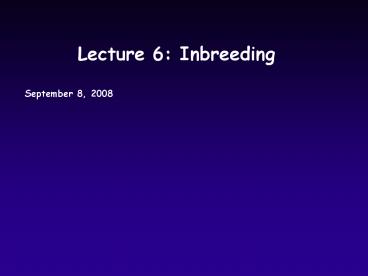Lecture 6: Inbreeding - PowerPoint PPT Presentation
1 / 22
Title:
Lecture 6: Inbreeding
Description:
Keep lab topics closely linked to lecture topics. Deleted ' ... http://i36.photobucket.com/albums/e4/doooosh/microcephaly.jpg. Important Points about Inbreeding ... – PowerPoint PPT presentation
Number of Views:2730
Avg rating:3.0/5.0
Title: Lecture 6: Inbreeding
1
Lecture 6 Inbreeding
September 8, 2008
2
Schedule Changes
- Moved Inbreeding lecture up to today
- Prerequisite for Lab 4 (LD)
- Also switching Lab 5 (Selection) and Lab 6
(Inbreeding) - Theyre interchangeable
- Keep lab topics closely linked to lecture topics
- Deleted Advanced Selection lecture
- Added a lecture Applications in Forensics
- See website for updated schedule
3
Last Time
- Measures of genetic variation
- Hardy-Weinberg departures revisited
- Multiple loci and independent segregation
- Estimating linkage disequilibrium
4
Today
- Introduction to nonrandom mating
- Effects of inbreeding on heterozygosity and
genetic diversity - Estimating inbreeding coefficients from pedigrees
- Estimating inbreeding from molecular marker data
5
Inbreeding
- Nonrandom mating within populations resulting in
greater than expected mating between relatives - Assumptions (for this lecture) No selection,
gene flow, mutation, or genetic drift - Inbreeding very common in plants and some insects
- Pathological results of inbreeding in animal
populations - Recessive human diseases
- Endangered species
6
Important Points about Inbreeding
- Inbreeding affects ALL LOCI in genome
- Inbreeding results in a REDUCTION OF
HETEROZYGOSITY in the population - Inbreeding BY ITSELF changes only genotype
frequencies, NOT ALLELE FREQUENCIES and therefore
has NO EFFECT on overall genetic diversity within
populations - Inbreeding equilibrium occurs when there is a
balance between the creation (through
outcrossing) and loss of heterozygotes in each
generation
7
Inbreeding can be quantified by probability (f)
an individual contains two alleles that are
Identical by Descent
8
Effect of Inbreeding on Genotype Frequencies
- fp is probability of getting two A1 alleles IBD
in an individual - p2(1-f) is probability of getting two A1 alleles
IBS in an individual - Inbreeding increases homozygosity and decreases
heterozygosity by equal amounts each generation - Complete inbreeding eliminates heterozygotes
entirely
9
Fixation Index
- The difference between observed and expected
heterozygosity is a convenient measure of
departures from Hardy-Weinberg Equilibrium
Where HO is observed heterozygosity and HE is
expected heterozygosity (2pq under Hardy-Weinberg
Equilibrium)
10
- Inbred fraction (f) and noninbred fraction (1-f)
- If departures from Hardy Weinberg are entirely
due to inbreeding, f can be estimated from
Fixation Index, F
11
Example Pitcairn Island
- In 1789, 25 sailors on the HMS Bounty mutinied
and put Captain Bligh and his loyalists off the
ship - Nine of these sailors landed on uninhabited
Pitcairn Island with 18 Tahitians and started a
new colony - Today about 50 people live on Pitcairn, and most
are direct descendants of the mutineers - What would you predict about genetic diversity on
Pitcairn today? - How is it likely to have changed since the
founding of the settlement?
12
Effects of Inbreeding on Allele Frequencies
- Allele frequencies do not change with inbreeding
- Loss of heterozygotes exactly balanced by gain of
homozygotes
13
Extreme Inbreeding Self Fertilization
- Common mode of reproduction in plants mate only
with self - Assume selfing newly established in a population
- ½ of heterozygotes become homozygotes each
generation - Homozygotes are NEVER converted to heterozygotes
14
Decline of Heterozygosity with Self Fertilization
- Steady and rapid decline of heterozygosity to zero
15
Partial Self Fertilization
- Mixed mating system some progeny produced by
selfing, others by outcrossing (assumed random) - Rate of outcrossing T
- Rate of selfing S
- TS1
- Heterozygosity declines to equilibrium point
16
Inbreeding Equilibrium
- Production of heterozygotes by outcrossing
balances loss of heterozygotes by selfing - For any value of p and S, there is a
characteristic equilibrium point, regardless of
starting genotype frequencies - Inbreeding coefficient also reaches equilibrium
point, purely a function of selfing rate
17
Estimating Selfing in Populations
- If inbreeding is principal cause of deviation,
Ff - Therefore, assuming equilibrium
- What are the assumptions of this calculation?
18
Estimating Inbreeding from Pedigrees
- Most accurate estimate of f derived from direct
assessment of relationships among ancestors
19
Estimating Inbreeding from Pedigrees
- Probability P contains two A1 alleles IBD
- from D
- (1/2)(1/2)(1/2) 1/8
- from E
- (1/2)(1/2)(1/2) 1/8
- Pr(A1A1(1/8)(1/8) 1/64
- Probability P contains two A2 alleles is same
- Probability P contains any alleles IBD is
therefore - 1/641/64 1/32
20
Chain Counting
- Count links to Common Ancestor starting with one
parent of inbred individual and continuing down
to other parent - D-B-CA-C-E
- N5 links
For multiple common ancestors, m
If common ancestors are inbred as well
Where fCAi is inbreeding coefficient of common
ancestor i
21
Calculate the inbreeding coefficient for P
Two Generations of Full-Sib Mating
CA2
CA1
B
D
P
22
Estimating Inbreeding from Progeny Sets
- Analyze genotypes of progeny arrays and mothers
- Estimate outcrossing rate based on nonmaternal
alleles






























